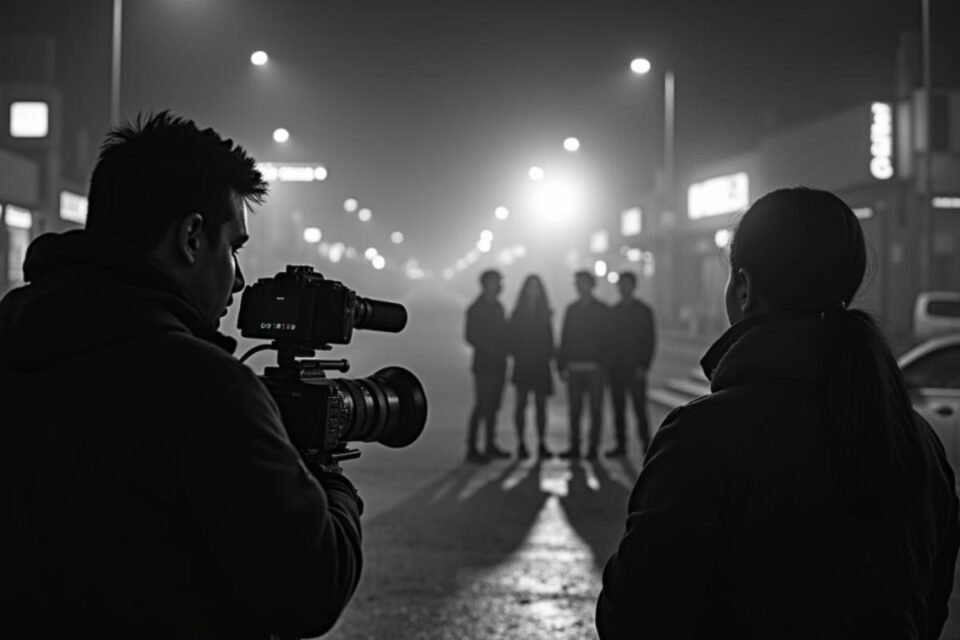“Cinema is a matter of what’s in the frame and what’s out.” – Martin Scorsese
Have you noticed how few movies leave us spellbound, while others fail to make an impact? It is not just the story, it is how the story is told! The lighting, camera angles, and visual composition need to be in perfect alignment to shape emotions and experiences that linger long after the credits roll. Although even then, many aspiring filmmakers underestimate the power of cinematography and direction as a combined force, often focusing on one while neglecting the other.
Now, you might ask if a director and a cinematographer are two distinct roles, or do they overlap?
The answer lies in creating a synergy between these two roles, which can position you as a professional filmmaker, unlike an amateur. So, whether you want to be behind the camera or calling the shots, this guide will help you take your first step into the world of filmmaking.
Role of a Director & Cinematographer
Let us see a film as a vision brought to life by a storyteller through moving images, and the two key catalysts for the moving images are the Director and the Cinematographer.
Who is the Director?
The director can be defined as the visionary force who is responsible for storytelling, pacing, and guiding actors to ultimately define the film’s tone, emotional depth, and character arcs.
It is the Director who needs to collaborate with every department, especially the cinematographer, to produce the final look or the end product (film).
Who is the Cinematographer?
A cinematographer, on the other hand, brings the director’s vision to life by choosing the right camera angles & lighting to create the perfect shot composition.
To put it, a cinematographer is responsible for the experience we feel as an audience.
Synergy Between Direction and Cinematography
A film’s success depends on how well the director’s vision and the cinematographer’s technical expertise blend together. Let us look into how both these distinct roles complement each other:
| Director | Cinematographer | Synergy Between the two |
| Decides the movie’s visual mood | Chooses lighting and camera settings | Both of them coordinate to create the film’s overview, which matches the director’s vision |
| Guides actors for emotional impact | Uses framing and camera angles to capture the emotions | Smooth coordination leads to the enhancement of emotions through visuals |
| Plans shot sequences | Decides lens, movement, and composition | An alignment in this aspect creates a flow in the storytelling or narrative of the film |
| Sets the story’s tone (happy, dark, intense) | Adjusts color and contrast | Matches the visual with the intended invocation of emotions |
What Happens When Cinematography and Direction Clash?
A director and cinematographer are like two artists painting on the same canvas. When they don’t sync, here is what commonly goes wrong:
-
Mood Mismatch
Let us take an example of a director who wants a dark, intense scene, but the cinematographer lights it brightly. Resultantly, the emotional depth gets lost, and the audience doesn’t feel the tension.
-
Weak Emotional Impact
Suppose there is a script that calls for a heartbreaking moment, but the camera angles and lighting fail to enhance the emotions. Instead of feeling the pain of the character, the audience feels nothing.
-
Inconsistent Storytelling
There are many films you can recall that have an inconsistent storytelling approach. So, practically, this happens when the cinematography shifts styles randomly, letting the film lose its identity, making it hard for the audience to stay engaged.
-
Poorly Executed Action Sequences
A director envisions a fast-paced chase, but the cinematographer’s shots are too slow and wide. The scene loses its excitement and feels staged instead of thrilling.
-
Poor Audience Connection
When visuals don’t match the narrative, the audience gets distracted, often noticing awkward angles or unnatural lighting.
Tips For Aspiring Directors & Cinematographers
If you are an aspiring filmmaker, learning about both direction and cinematography can help you avoid these common mistakes.
- Explore the concept of visual storytelling, specifically by learning how lighting, colors, and camera movement affect emotions.
- Work on your communication skills, as directors and cinematographers must collaborate to align their vision.
- Start with short films, even with a phone camera, as you will gain first-hand experience of how to frame shots and set moods.
- Lastly, get professional training, as learning from experts and industry professionals can help you sharpen your skills faster.
Conclusion
When cinematography and direction work in harmony, films become more than just stories and transform into experiences that captivate audiences, which is what cinema is about at the end of the day. A well-directed scene with poor visuals can feel dull, while breathtaking cinematography without a strong vision can lack depth. Hence, successful filmmakers are often proficient in both aspects, ensuring that every frame enhances the storytelling.
Schools like AAFT School of Cinema bridge the gap between raw talent and professional expertise, offering state-of-the-art facilities like Virtual Sets, Mini Film Training Studios, and Post-Production Labs. Students get access to industry-standard tools such as Adobe Premiere Pro, Blackmagic cameras, and Chroma Studios, helping them refine their craft with mentorship from industry experts.
With specialized UG, PG, and Diploma programs in Direction, Cinematography, Acting, and Post-Production, AAFT can help you gain the requisite skills needed to navigate the dynamic world of cinema.
So, if you are serious about making a mark in the film industry, don’t just dream, take action. Because in cinema, just like in life, what’s in the frame and what’s left out can make all the difference. After all, behind every great film is a team that understands the magic of storytelling through both vision and visuals.


